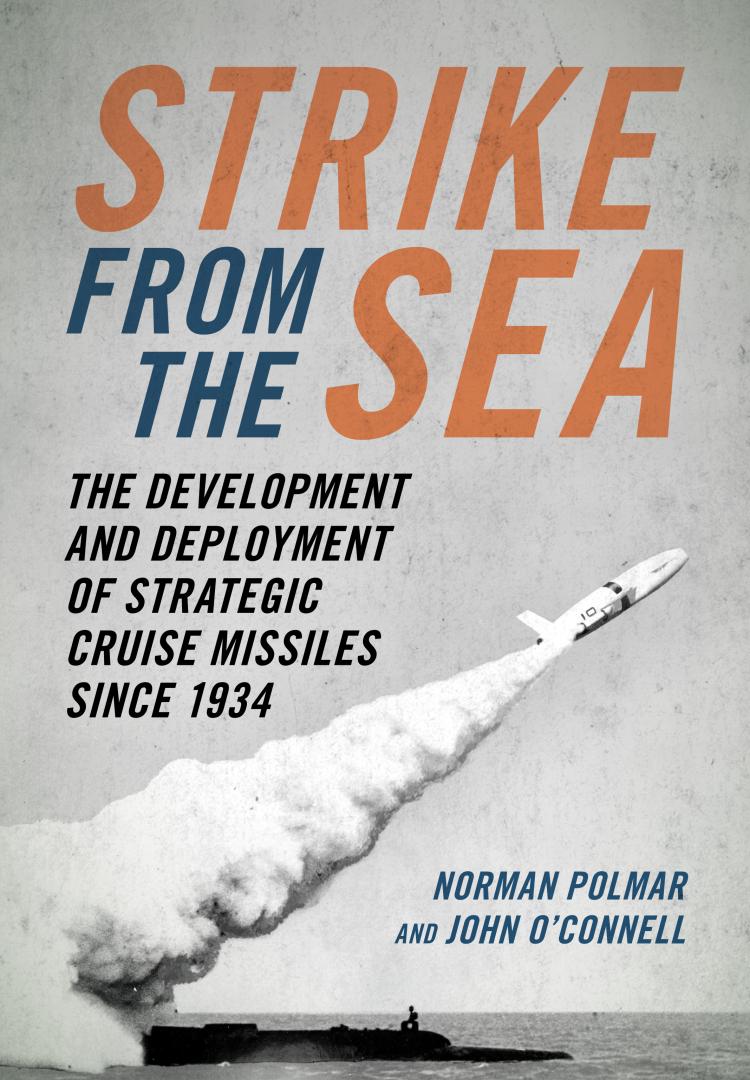Strike from the Sea
- Subject: Cold War | Summer 2024 Sale
- Format:
Hardcover
- Pages:
240pages
- Published:
September 15, 2020
- ISBN-10:
1682473899
- ISBN-13:
9781682473894
- Product Dimensions:
10 × 7 × 1 in
- Product Weight:
24 oz
Overview
The cruise missile—also referred to as a guided missile—is a widely employed tactical and strategic weapon, capable of striking ground or ship targets with conventional or nuclear warheads. Before the development of ballistic missiles for attacking an enemy’s territory, the U.S. and Soviet strategic arsenals had land-attack cruise missiles to deliver nuclear warheads. Subsequently, the U.S. and Soviet Navies, as well as other fleets, developed tactical anti-ship and anti-submarine cruise missiles.
Strike from the Sea addresses the U.S. Navy’s Regulus missile program—the world’s first submarine weapon for attacking an enemy homeland with a nuclear warhead—and the similar Soviet Navy’s cruise missile efforts. Prior to Regulus a few of the world’s submarines had deck guns that were employed for assaulting coastal targets; indeed, the British built a class of “submarine monitors” with large-caliber guns for attacking coastal targets.
The U.S. Navy’s rapid and successful development of the Polaris Submarine-Launched Ballistic Missile (SLBM) and budgetary constraints caused the cancellation of advanced submarine-launched cruise missiles—the Regulus II as well as the follow-on Rigel and Triton. Submarines armed with the Regulus I missile continued on patrols in the North Pacific until mid-1964, when they were replaced on the “deterrent” role by Polaris missile submarines. The Soviet Navy continued the development and deployment of anti-ship cruise missiles, which retained some land-attack capabilities.
About the Author
Editorial Reviews
“A fascinating history and analysis of the cruise missile weapons system which introduced the era of guided missiles, this book looks at the weapon that was eclipsed in the U.S. (but not the Soviet Union) for decades by the ballistic missile, and which has now come back in a modern form, to present potential strategic challenges to the nation, and fresh challenges to the U.S. Navy.” —RADM Thomas A. Brooks USN (Ret.), former Director of Naval Intelligence, co-author of Admiral Gorshkov: The Man Who Challenged the U.S. Navy
“Norman Polmar and John O’Connell have provided an in-depth and fascinating look at the history and evolution of submarine-launched cruise missiles from both sides of the Iron curtain. This topic is not only of historical interest, but an issue increasingly back in focus in the age of great power competition.” —Magnus Nordenman, author of The New Battle for the Atlantic: Emerging Naval Competition with Russia in the Far North
“In October 1962, the placement of Soviet missiles in Cuba presented such a threat that the U.S. risked war to attain their removal. Yet as Norman Polmar and John O'Connell masterfully detail, the Soviets successfully worked to attain this capability through other means. Strike from the Sea brings new understanding to the evolution of the nuclear strategic balance during a crucial period of the Cold War.” —David F. Winkler, Ph.D., co-author To Defend and Deter: The Legacy of the United States Cold War Missile Program
“Authoritative, masterfully written, and drawing from the experiences and knowledge of naval officer John O’Connell and the vast breadth of knowledge of historian and analyst Norman Polmar, this is a must-have book on one of the most critical developments of modern naval armament.” —James P. Delgado, maritime archaeologist, historian and author of War at Sea: A Shipwrecked History
“This book gives very good insight into the design and deployment of Regulus I and II and the perceived comparison of life at sea with it compared with the early Polaris boats, as one would expect from a senior officer who had served in a guided-missile submarine…. Recommended to anyone with an interest in the development and deployment of Regulus.” —Australian Naval Institute
“This book gives very good insight into the design and deployment of Regulus I and II and the perceived comparison of life at sea with it compared with the early Polaris boats…. I would certainly recommend this book to anyone with an interest in the development and deployment of Regulus.” —The Naval Review
“U.S. Naval Institute Press has another winner in Strike from the Sea: The Development and Deployment of Strategic Cruise Missiles Since 1934 by Norman Polmar and John O’Connell. This carefully researched and documented book –– filled with photos, diagrams, statistics, and appendices –– presents a history of some of the world’s most dangerous tools of war…. Strike from the Sea is compelling and thought-provoking.” —Navy Reads
“This book nicely fills a void in naval weaponry literature.” —Seapower
“Strike from the Sea succeeds in its stated purpose: compressing the highly technical story of strategic cruise missiles into a succinct volume intelligible to interested common readers as well as specialists.” —Michigan War Studies Review
“Strike From The Sea will be enjoyed by readers with an interest in military technology, the Cold War, and modern naval history. The book is extensively illustrated with well-chosen black and white photos, and provided with many helpful aids to the reader, such as a list of acronyms, and appendices with technical specifications of many of the missiles and submarines described.” —Strategy Page
"Strike From the Sea is an impressive and invaluable contribution to the field of naval history. The author’s deep understanding of the subject matter, coupled with an engaging writing style, makes this book a compelling read for anyone interested in the evolution of modern warfare. From military historians to defense analysts, this comprehensively researched account offers an illuminating exploration of the strategic significance and technological advancements surrounding cruise missiles throughout history." —The Military Reviewer





